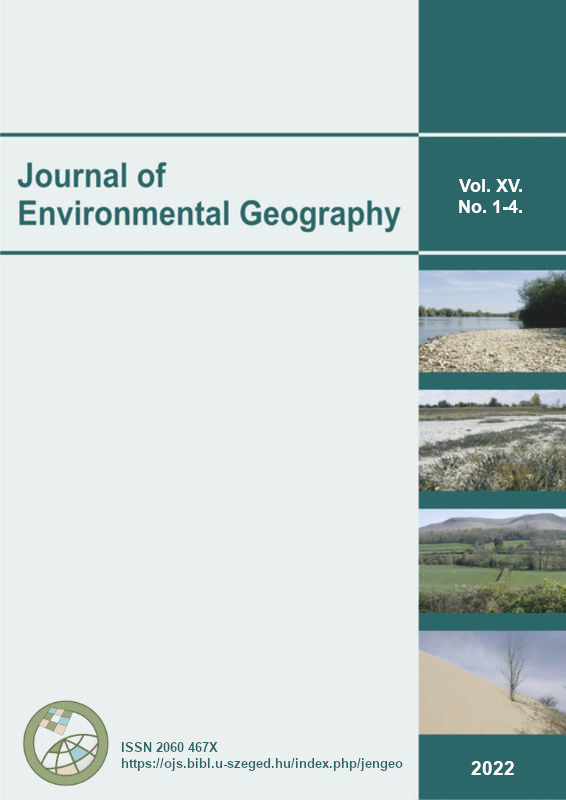Assessing the Effects of LULC Change on Landslide Hazards in Rwanda A Case Study in Nyabihu District
Main Article Content
Abstract
Landslides have become important environmental hazard in hilly regions of Rwanda such as Nyabihu district. They are characterized by the downslope movement of debris or other earth materials which damage or destroy everything found in their way such as infrastructure, croplands, and even cause a number of human deaths. The main triggering factors of landslides in Rwanda are intense rainfall and land use/land cover (LULC) change. Therefore, the objective of this study was to assess the LULC change effects on landslide occurrences. LULC maps of 2005 and 2015 were generated and overlaid with mapped landslides. Maximum likelihood classification was used to classify the Landsat satellite images. The results revealed a remarkable decrease of agricultural land, while all other LULC types have increased in the studied period. It was noted that most of the landslides occurred in agricultural land. The study results are expected to be useful for landslide hazard management decisions, land use planning and management regulations, so as to minimize the likelihood of landslide occurrences and their resultant impacts.
Downloads
Article Details

This work is licensed under a Creative Commons Attribution-NonCommercial-NoDerivatives 4.0 International License.
x
References
Anderson, M. G., Holcombe, E. 2013. Community-Based Landslide Risk Reduction: Managing Disasters in Small Steps. World Bank Publications.
Bennett, G. L., Miller, S. R., Roering, J. J., Schmidt, D. A. 2016. Landslides , threshold slopes , and the survival of relict terrain in the wake of the Mendocino Triple Junction. Geology 44(5), 1–4. DOI: 10.1130/G37530.1
Bizimana, H., Sönmez, O. 2015. Landslide Occurrences in The Hilly Areas of Rwanda, Their Causes and Protection Measures. Disaster Science and Engineering, 1(1), 1–7. Online available at http://www.disasterengineering.com/tr/download/article-file/408168
Chen, C., Huang, W. 2012. Land use change and landslide characteristics analysis for community-based disaster mitigation. Environ Monit Assess., 185, 4125–4139. DOI: 10.1007/s10661-012-2855-y
Dewitte, O., Bibentyo, T. M., Balegamire, C., Basimike, J., Matabaro, S. K., Delvaux, D., Kervyn, F. 2017. Landslide hazard in Bukavu (DR Congo): a geomorphological assessment in a data-poor context. Geophysical Research Abstracts, 19, 3–4.
Eastman, J. R. 2003. IDRISI Kilimanjaro: Guide to GIS and Image Processing. Clark University: Worcester, MA, USA. 306 p.
Froude, M. J., Petley, D. N. 2018. Global fatal landslide occurrence from 2004 to 2016. Nat. Hazards Earth Syst. Sci., 18(8), 2161–2181. DOI: 10.5194/nhess-18-2161-2018
Gao, Y., Zhang, W. 2009. A simple empirical topographic correction method for ETM + imagery. International Journal of Remote Sensing, 30(9), 2259–2275. DOI: 10.1080/01431160802549336
Gurung, A., Gurung, O. P., Karki, R., Oh, S. E. 2013. Improper agricultural practices lead to landslide and mass movement disasters: A case study based on upper Madi watershed, Nepal. Emir. J. Food Agric, 25(1), 30–38. DOI: 10.9755/ejfa.v25i1.5341
Haggag, M., Kalisa, J. C., Abdeldayem, A. W. 2016. Projections of precipitation, air temperature and potential evapotranspiration in Rwanda under changing climate conditions. African Journal of Environmental Science and Technology, 10(1), 18–33. DOI: 10.5897/AJEST2015.1997
Huabin, W., Gangjun, L., Weiya, X., Gonghui, W. 2005. GIS-based landslide hazard assessment: an overview. Progress in Physical Geography: Earth and Environment, 29(4), 548–567. DOI: 10.1191/0309133305pp462ra
Karsli, F., Atasoy, M., Yalcin, A., Reis, S., Demir, O., Gokceoglu, C. 2009. Effects of land-use changes on landslides in a landslide-prone area (Ardesen, Rize, NE Turkey). Environmental Monitoring and Assessment, 156(1–4), 241–255. DOI: 10.1007/s10661-008-0481-5
Kisioh, H. 2015. Gishwati Forest Reserve, Three Years Interim Management Plan 2015-2018. Rwanda.
Knapen, A., Kitutu, M. G., Poesen, J., Breugelmans, W., Deckers, J., Muwanga, A. 2006. Landslides in a densely populated county at the footslopes of Mount Elgon (Uganda): Characteristics and causal factors. Geomorphology, 73, 149–165. DOI: 10.1016/j.geomorph.2005.07.004
MacNeil, D. J., Steele, D. P., McMahon, W., Carder, D. R. 2001. Vegetation for slope stability. TRL Report 515, TRL, Crowthorne.
Mausel, P., Brondízio, E., Moran, E. 2004. Change detection techniques. International Journal of Remote Sensing, 25(12), 2365–2407. https://doi.org/10.1080/0143116031000139863
MIDIMAR 2015. The National Risk Atlas of Rwanda. Republic of Rwanda, Ministry of Disaster Management and Refugee Affairs (MIDIMAR). Online available at: https://www.gfdrr.org/en/publication/rwanda-national-risk-atlas
MINAGRI. (2018b). Rwanda Indicative feeder roads Development Project. Environmental and Social Impact Assessment / Environmental and Social Management Plan for indicative feeder roads in the District of Nyabihu, Rwanda - Project ID: P 126498.
MININFRA 2015. Rwanda HABITAT III Report. Kigali. Republic of Rwanda, Ministry of Infrastructure (MININFRA). Online available at: https://habitat3.org/wp-content/uploads/ RWANDA-HABITAT-III-REPORT_17.12.15.pdf
Mugagga, F., Kakembo, V., Buyinza, M. 2012. Land use changes on the slopes of Mount Elgon and the implications for the occurrence of landslides. Catena, 90, 39–46. DOI: 10.1016/j.catena.2011.11.004
Muhire, I., Ahmed, F. 2015. Spatio-temporal trend analysis of precipitation data over Rwanda. South African Geographical Journal, 97(1), 50–68. DOI: 10.1080/03736245.2014.924869
Noroozi, A. G., Hajiannia, A. 2017. The Effect of Vegetation on Slope Instability as Predicted by the Finite Element Method. EJGE, 20(28), 13487–13496.
Nsengiyumva, J. B., Luo, G., Nahayo, L., Huang, X., Cai, P. 2018. Landslide Susceptibility Assessment Using Spatial Multi-Criteria Evaluation Model in Rwanda. International Journal of Environmental Research and Public Health, 15(2), 243. DOI: 10.3390/ijerph15020243
Popescu, M. E. 1996. From Landslide Causes to Landslide Remediation, Special Lecture. Proc. 7th Int. Symp. on Landslides, Trondheim, 1, 75–96.
Prasad, N. B. N. 1995. Landslides-Causes & Mitigation.
Reichenbach, P., Busca, C., Mondini, A. C., Rossi, M. 2014. The Influence of Land Use Change on Landslide Susceptibility Zonation: The Briga Catchment Test Site (Messina, Italy). Environmental Management, 54, 1372–1384. DOI: 10.1007/s00267-014-0357-0
REMA 2015. Rwanda - State of Environment and Outlook Report 2015: Greening agriculture with resource efficient, low carbon and climate resilient practices. Kigali. Rwanda Environment Management Authority (REMA). DOI: 10.13140/RG.2.1.5148.6328
Xu, C. 2015. Preparation of earthquake-triggered landslide inventory maps using remote sensing and GIS technologies: Principles and case studies. Geoscience Frontiers, 6(6), 825–836. DOI: 10.1016/j.gsf.2014.03.004





